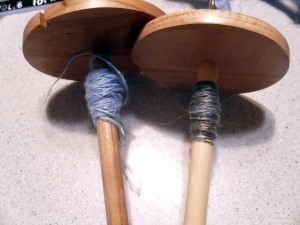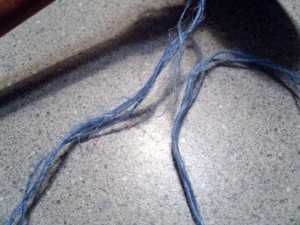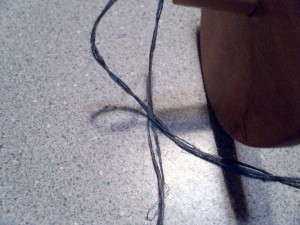I found so much information on Flax. The processing to make this plant spinnable is really quite labor intensive. There are 3 more steps taken to make flax spinnable, threshing, retting, and dressing.

- Tool for threshing flax
The tool above reminds me of my hackle or wool combs.
Threshing is the process of removing the seeds from the rest of the plant. As noted in the last post, the threshing could be done in the field by a machine, or in another process, a description of which follows:
The process is divided into two parts: the first part is intended for the farmer, or flax-grower, to bring the flax into a fit state for general or common purposes. This is performed by three machines: one for threshing out the seed, one for breaking and separating the straw (stem) from the fiber, and one for further separating the broken straw and matter from the fiber. In some cases the farmers thrash out the seed in their own mill and therefore, in such cases, the first machine will be unnecessary.
The second part of the process is intended for the manufacturer to bring the flax into a state for the very finest purposes, such as lace, cambric, damask, and very fine linen. This second part is performed by the refining machine only.
The threshing process would be conducted as follows:
- Take the flax in small bundles, as it comes from the field or stack, and holding it in the left hand, put the seed end between the threshing machine and the bed or block against which the machine is to strike; then take the handle of the machine in the right hand, and move the machine backward and forward, to strike on the flax, until the seed is all threshed out.
- Take the flax in small handfuls in the left hand, spread it flat between the third and little finger, with the seed end downwards, and the root-end above, as near the hand as possible.
- Put the handful between the beater of the breaking machine, and beat it gently till the three or four inches, which have been under the operation of the machine, appear to be soft.
- Remove the flax a little higher in the hand, so as to let the soft part of the flax rest upon the little finger, and continue to beat it till all is soft, and the wood is separated from the fiber, keeping the left hand close to the block and the flax as flat upon the block as possible
- The other end of the flax is then to be turned, and the end which has been beaten is to be wrapped round the little finger, the root end flat, and beaten in the machine till the wood is separated, exactly in the same way as the other end was beaten.
Retting is the process of rotting away the inner stalk, leaving the outer fibers intact. At this point there is still straw, or coarse fibers, remaining. To remove these the flax is “broken,” the straw is broken up into small, short bits, while the actual fiber is left unharmed, then “scutched,” where the straw is scraped away from the fiber, and then pulled through “hackles,” which act like combs and comb the straw out of the fiber.
There are several methods of retting flax. It can be retted in a pond, stream, field or a tank. When the retting is complete the bundles of flax feel soft and slimy, and quite a few fibers are standing out from the stalks. When wrapped around a finger the inner woody part springs away from the fibers.
Pond retting is the fastest. It consists of placing the flax in a pool of water which will not evaporate. It generally takes place in a shallow pool which will warm up dramatically in the sun; the process may take from only a couple days to a couple weeks. Pond retted flax is traditionally considered lower quality, possibly because the product can become dirty, and easily over-retts, damaging the fiber. This form of retting also produces quite an odor.
Stream retting is similar to pool retting, but the flax is submerged in bundles in a stream or river. This generally takes longer than pond retting, normally by two or three weeks, but the end product is less likely to be dirty, does not smell as bad and, because the water is cooler, it is less likely to be over-retted.
Both Pond and Stream retting were traditionally used less because they pollute the waters used for the process.
Field retting is laying the flax out in a large field, and allowing dew to collect on it. This process normally takes a month or more, but is generally considered to provide the highest quality flax fibers, and produces the least pollution.
Retting can also be done in a plastic trash can or any type of water tight container of wood, concrete, earthenware or plastic. Metal containers will not work, as an acid is produced when retting, and it would corrode the metal. If the water temperature is kept at 80°F, the retting process under these conditions takes 4 or 5 days. If the water is any colder then it takes longer. Scum will collect at the top and an odor is given off the same as in pond retting.
Dressing the flax is the term given to removing the straw from the fibers. Dressing consists of three steps: breaking, scutching, and heckling. The breaking breaks up the straw, then some of the straw is scraped from the fibers in the scutching process, then the fiber is pulled through heckles to remove the last bits of straw.
The dressing is done as follows:

- Breaking: The process of breaking breaks up the straw into short segments. To do it, take the bundles of flax and untie them. Next, in small handfuls, put it between the beater of the breaking machine (a set of wooden blades that mesh together when the upper jaw is lowered, which look like a paper cutter but instead of having a big knife it has a blunt arm), and beat it till the three or four inches that have been beaten appear to be soft. Move the flax a little higher and continue to beat it till all is soft, and the wood is separated from the fiber. When half of the flax is broken, hold the beaten end and beat the rest in the same way as the other end was beaten, till the wood is separated.

- Scutching: In order to remove some of the straw from the fiber, it helps to swing a wooden scutching knife down the fibers while they hang vertically, thus scraping the edge of the knife along the fibers and pull away pieces of the stalk. Some of the fiber will also be scutched away, this cannot be helped and is a normal part of the process.

- Heckling: In this process the fiber is pulled through various different sized heckling combs or heckles. A heckle is a bed of “nails” – sharp, long-tapered, tempered, polished steel pins driven into wooden blocks at regular spacing. A good progression is from 4 pins per square inch, to 12, to 25 to 48 to 80. The first three will remove the straw, and the last two will split and polish the fibers. Some of the finer stuff that comes off in the last hackles is called “tow” and can be carded like wool and spun. It will produce a coarser yarn than the fibers pulled through the heckles because it will still have some straw in it.
I have to say I’m really impressed now I understand why linen was so prized and is somewhat today. All of these steps have to happen before any dying or spinning can take place. I also wonder a few things I wonder if retting is as smelly as skirting and scouring a nasty fleece. I wonder what was more prized linen knittedr linen woven.
Anyway here is how my dye job turned out.

natural on left , bleached on right


I had dyed some natural color flax and bleached flax in Cushing’s Direct Dyes color Copenhagen Blue. I love the differences in the fibers. I was wondering”how should I spin this ? Should I spin it wet or dry?” I decided to try both and see what happened. I spun the lighter blue without wetting. I spun the darker blue with wetting.



It spun about light fingering weight with moderate twist, slightly hairy.


The wetted flax spun much smoother and I spun much thinner more like laceweight. It used much less twist. An interesting comparison I like them both, I prefer the color on the bottom though (however I don’t feel the camera did it justice).
Comment below and tell me which way you like better wet spun or dry spun.










I have found myself with a flax breaking machine with metal like a guillotine instead of made of all wood. I had no idea what it had been used for until I read your blog. Thanks